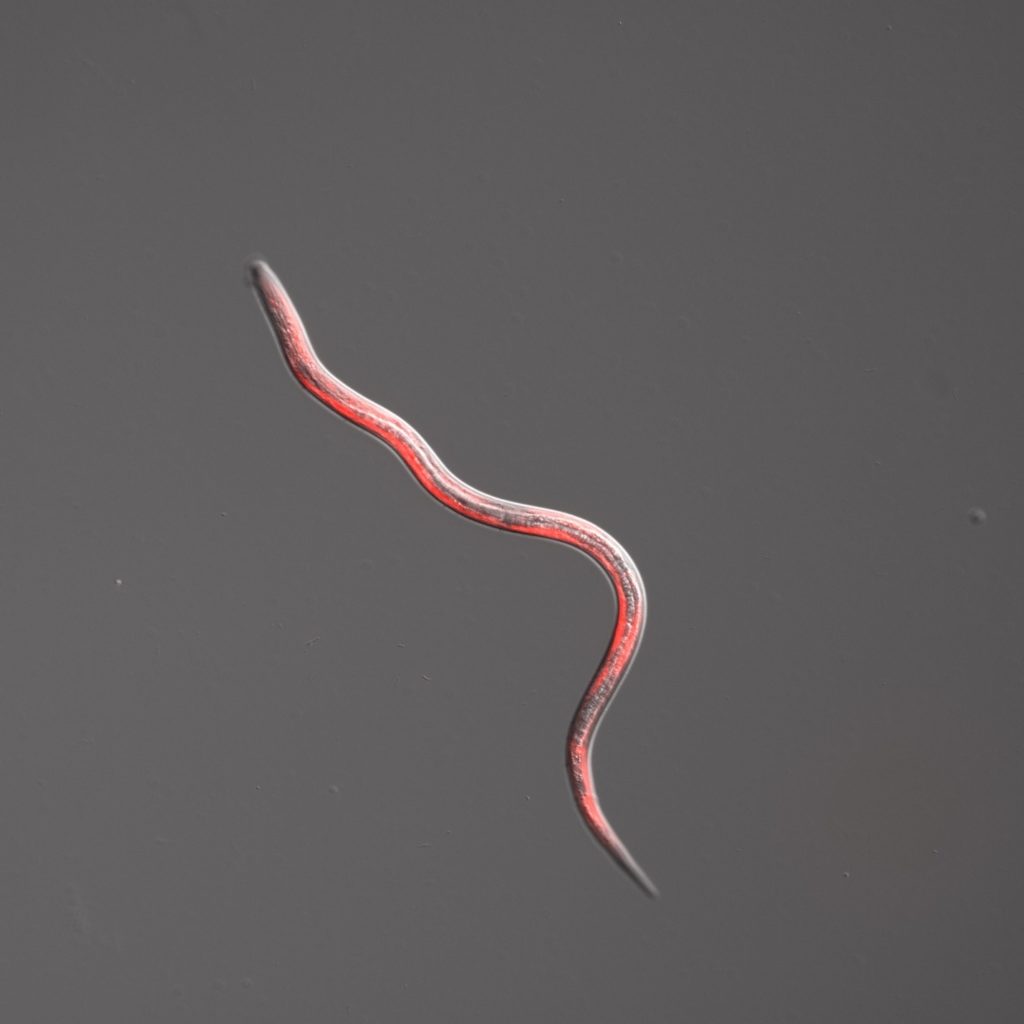
Stories
Elissa Hallem – A Pivot to Human Parasites

Elissa Hallem wasn’t always immersed in the world of parasitic roundworms. In fact, she spent much of her early research career studying Drosophila, the common fruit fly.
Inspired to pursue research after participating in Johns Hopkins University’s Center for Talented Youth program, Hallem began volunteering in Larry Zipursky’s lab at the University of California, Los Angeles, while in high school. “Dr. Zipursky’s lab studies the visual system of Drosophila. This was the first time that I experienced a lab environment and what it was like to do research. It was an amazing experience that sparked my interest in a research career, and working with Drosophila was a lot of fun.”
After graduating with a degree in biology and chemistry from Williams College, Hallem pursued a doctorate in neuroscience at Yale University. Hallem was once again introduced to Drosophila, a model organism for exploring sensory behaviors. “I was studying odor coding in the Drosophila antenna for my Ph.D.,” she recalls. “We were trying to decode the Drosophila odorant receptors. The receptors had been recently identified, and very little was known about their functional properties or odor specificities. As part of this research, we realized that we could use the same decoding system we were using for the Drosophila odorant receptors to study mosquito odorant receptors. Excitingly, we were able to identify a mosquito odorant receptor that responds to a human sweat odorant.”
Though brief, this introduction to mosquito receptors towards the end of Hallem’s doctoral program was enough to spark a lifelong interest in parasites and disease vectors.
“I realized that a lot of people were studying host-seeking behaviors of mosquitoes—how they find humans from large distances—but there was almost nothing known about parasitic worms, which are a huge health problem,” explains Hallem. “That’s really what got me interested in transferring my background in sensory neurobiology to the study of parasitic worms.”
Hallem completed a post-doctoral fellowship at the California Institute of Technology prior to returning to UCLA in 2011 to establish her own lab. She is now a professor and vice chair of graduate studies in the Department of Microbiology, Immunology, and Molecular Genetics, as well as director of the Immunity, Microbes, and Molecular Pathogenesis graduate program. The parasitic worms that the Hallem lab studies are gastrointestinal parasites of humans, including the human-parasitic threadworm Strongyloides stercoralis and the human-parasitic hookworm Ancylostoma ceylanicum. Her lab examines how these parasites use host-emitted sensory cues to find and invade human hosts, and also probes the genetic and neurobiological underpinnings of host-seeking and host-invasion behaviors.
“When applying for a Rita Allen award, focus on the ideas you are most excited about—even if they’re risky—and don’t be afraid to let your enthusiasm show.”
Parasitic worms may seem like an unusual topic to pursue; however, they are a major health problem worldwide and infect one quarter of the entire world population, especially in low-resource communities with poor sanitation infrastructure. In the United States, parasitic worm infections are primarily found in low-resource, marginalized communities. Exposure can occur, for example, when children come into contact with septic tank sewage leakage while they play barefoot outside.
In studying the sensory behaviors of human-parasitic worms, Hallem further explains, she is trying to understand how worms detect humans in their environment and navigate toward them for infection. “They penetrate directly through the skin, and people get infected when they have exposed skin. Generally, since the infective larvae are soil dwelling, people get infected when they stand or walk barefoot in contaminated soil. We’re studying both how the worms navigate toward a human host, and how they penetrate through the skin once they’ve found a host.”
Developing a strategy to prevent worm infections would greatly benefit human health in these communities. While treatment strategies exist for clearing infections, they don’t prevent the infection from reoccurring. Hallem explains, “If you live in an endemic area, you can clear an existing infection, but you will likely get infected again. Another issue is that drug resistance is likely to become a major problem in the near future. This is already a huge problem for drugs that are used to treat nematode-infected livestock. We hope that a better understanding of the basic biology of these parasites—in particular, the biological processes that lead them to seek out and infect a host—will lead to the development of new strategies for preventing infections.”
One of the most significant research achievements from Hallem and her colleagues is the development of new biological tools to study the molecular and neural basis of worm behaviors. “We developed a method for making homozygous mutations with CRISPR in a parasitic worm. Before that, it was very difficult to study gene function in parasitic worms because RNA interference [a method to knock-down gene expression] hadn’t worked reliably. Now, in the human-parasitic nematode Strongyloides stercoralis, we can disrupt a gene of interest to study its function.” This method has since been used by several other labs.

More recently, Hallem’s lab published a paper identifying neural mechanisms that enable parasitic worms to seek out and infect humans using body heat. “We looked at differences in sensory neuron function in free-living versus parasitic worms to try to pinpoint the specific functional adaptations in the parasitic worms that enable them to migrate toward a human host,” Hallem elaborates. “The temperature-sensing neurons of the human-parasitic worms have specific functional adaptations that really make sense in terms of the need of this parasite to follow a temperature gradient all the way up to a human host.”
Here, Hallem shares her reflections on becoming a Rita Allen Scholar, advice for early career individuals, and how she spends her time outside of the lab.
What do you remember about the process of becoming a Rita Allen Scholar?
When I wrote my Rita Allen Foundation proposal, it was mostly on parasitic worms that infect insects. I think I had a line or two in my proposal about how I wanted to extend these results to human-parasitic worms in the future. During the interview, I wasn’t sure whether I should mention that I wanted to switch to studying human-parasitic worms, because my publications at that point were focused on insect-parasitic worms. But then at the end of the interview, one of the [Scientific Advisory Committee members] asked, “You mentioned you’re interested in extending this work to human-parasitic worms—is that still something you plan to do?” I replied, “Yes.” and he said, “That’s great, you should do it.” It was really nice to have that encouragement as I decided to take my research in a new direction.
I certainly wasn’t in a position to apply for NIH funding on human-parasitic worms when I had never done any work with them before, but the Rita Allen Foundation was so enthusiastic about the idea. Having the Rita Allen [Award] gave me the flexibility to take my research in this exciting new direction, and I am extremely grateful for that early support.
What advice would you give other early career individuals who are interested in applying for a Rita Allen Award?
The Rita Allen Foundation is interested in funding great science. They want to fund what you’re passionate about and what you think will have a big impact. When applying for a Rita Allen award, focus on the ideas you are most excited about—even if they’re risky—and don’t be afraid to let your enthusiasm show.
Are there any passions, or interests, you have outside of the lab you would like to share?
I like to read, travel, and spend time with my family.